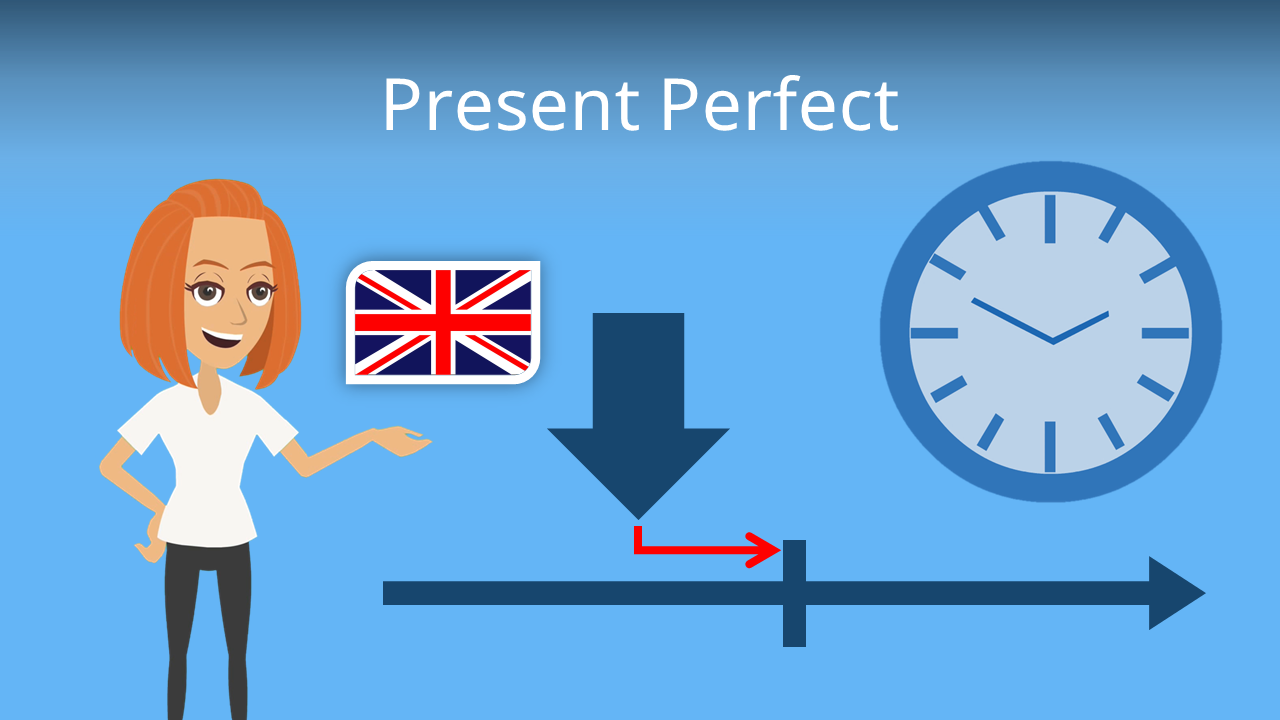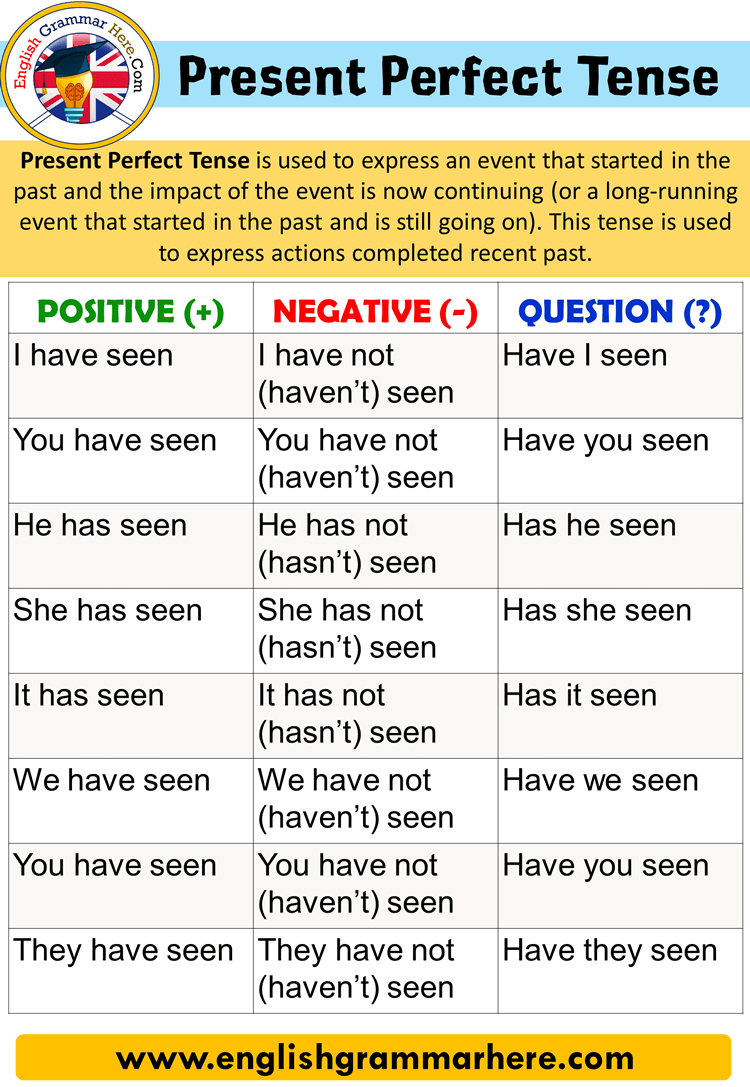Frage und Verneinung im Present Perfect Unterrichtsmaterial im Fach Englisch Fragen

PRESENT PERFECT / Basics, Verneinung & Fragen erklärt + Übungen Englisch YouTube
Present Perfect with for and since. The present perfect is also used with for and since to talk about actions that began in the past and continue to the present. "I've lived here since 2004." "I've lived here for 8 years." Since is used with a point in time, and means "from that point in time until the present."Use since with dates (2011, January, Tuesday, etc.), times (6:15.

Present Perfect • Bildung, Verwendung & Beispielsätze · [mit Video]
Übung 4. Markiere die richtige Aussage zur Verneinung im Present Perfect. Im Present Perfect muss ich für eine Verneinung not vor have / has einfügen. Im Present Perfect können bei der Verneinung keine Kurzformen benutzt werden. Im Present Perfect können bei der Verneinung Kurzformen benutzt werden: haven't / hasn't.

60 Sentences Example in Present Perfect Tense Englishtivi
#presentperfect #thepresentperfect #grammarbox Dieses Video behandelt die Verwendung und Bildung des Present Perfect Simples: positive und negative Sätze (ke.

Frage und Verneinung im Present Perfect Unterrichtsmaterial im Fach Englisch Fragen
The affirmative form of the Present Perfect Tense is used to express an action or event that has occurred at an unspecified time in the past or that began in the past and continues to the present. The structure of the affirmative form is as follows: Subject + have/has + past participle of the verb. Examples:

Tandem Activity / Tandembögen zu Aussagen und Verneinungen im Present Perfect
The Present Perfect tense is a rather important tense in English, but it gives speakers of some languages a difficult time. That is because it uses concepts or ideas that do not exist in those languages. In fact, the structure of the Present Perfect is very simple. The problems come with the use of the tense.

Englisch present perfect since for Übungskarten Unterrichtsmaterial im Fach Englisch
Present Perfect, Verneinungen, Grammatikübungen, Englisch Lernen, Übungen. Aufgaben-Nr. 4154Setze das Verb in Klammern in die Lücke und bilde verneinte Aussagesätze im Present Perfect.. Beispiel aufklappen

Englisch Present Perfect Übersicht Unterrichtsmaterial im Fach Englisch Englisch
1. be als Vollverb 2. do als Vollverb 3. have als Vollverb Bei bejahten Sätzen und der Verneinung können für have (has) natürlich auch die Kurzformen stehen. Erläuterungen Present Perfect (Kurzübersicht) be, do, have im Present Perfect Fragen im Present Perfect Kurzformen und Langformen im Present Perfect Du befindest dich hier: Start

Das present perfect einfach erklärt Einfach Englisch YouTube
To make the positive present perfect tense, use: 'have' / 'has' + the past participle. Make the past participle by adding 'ed' to regular verbs (for example, 'play' becomes 'played') There are a few verbs that change their spelling when you add 'ed' (for example, 'study' becomes 'studied') We also have some completely irregular verbs.

Present Perfect Tense Definition, Examples, & Rules» OnlyMyEnglish
More Examples of the Present Perfect Tense. Here are some more examples of the present perfect tense: The board has decided to uphold the appeal. (This sentence carries the connotation that the board continues to uphold the appeal.) I have taken the wrong path. (Connotation: I am still on the wrong path.)

Grammar present perfect progressive. Worksheet and solution meinUnterricht
The Oxford Learner's Dictionary defines the present perfect tense as "the form of a verb that expresses an action done in a time period up to the present, formed in English with the present tense of 'have' and the 'past participle' of the verb, as in I have eaten ."

Present Perfect Tense, Using and Examples English Grammar Here
Present Perfect: Aussagen & Verneinungen TASK 1: Complete the sentences with the correct form of the verbs in brackets in the present perfect tense. a) Tessa _____has just gone_____ (just, go) to school. b) Sara____has already watched__ (already, watch) the movie two times. c) Hannah ____hasn't met_____ (not, meet) her boyfriend yet.

Pin on Schulnotizen
Das present perfect simple wird dann verwendet, wenn ein Ereignis in der Vergangenheit begonnen hat und eine Verbindung zu Gegenwart besteht.. Verneinung. I, you, we, they - have not (haven't) + 3rd form. he, she, it - has not (hasn't) + 3rd form. They haven't tidied up their room so far. - He hasn't finished his homework yet. Fragen. Have.

Structure of Present Perfect Tense English Study Page
0:00 / 8:41 Present Perfect Simple Tense - auf Deutsch erklärt EnglischEndlichEinfach 27.5K subscribers Subscribe Share 43K views 3 years ago Englische Grammatik auf Deutsch erklärt MEIN TIPP: In.

PRESENT PERFECT Merkblatt (mehrere Versionen) Unterrichtsmaterial im Fach Englisch
The present perfect tense is a verb form used to refer to a past action or situation that has a present consequence. It's typically used to indicate experience up to the present, recent actions, or a change that occurred over a period of time.

Sentences Fragen mit Verneinung (Basic Level) Unterrichtsmaterial im Fach Englisch
Du verwendest das Present Perfect (auch: Present Perfect Simple), wenn du über eine Handlung aus der Vergangenheit sprichst, die einen Einfluss auf die Gegenwart hat. Aber wie wird das Present Perfect gebildet? Du nutzt dafür have oder has und fügst das Past Participle (Infinitiv + -ed) hinzu. Hier siehst du 3 Beispiele für Present Perfect Sätze:

Present Perfect (Englisch) Regeln, Bildung und Beispiele
1. Für Handlungen, die bis in die Gegenwart reichen. I have lived in Hamburg since 2010. - Ich lebe seit 2010 in Hamburg (und lebe immer noch dort). 2. Für Handlungen, die noch eine direkte Auswirkung auf die Gegenwart haben. Are you hungry? - No, I've just eaten. - Hast du Hunger? - Nein, ich habe gerade gegessen (und bin deshalb satt). 3.